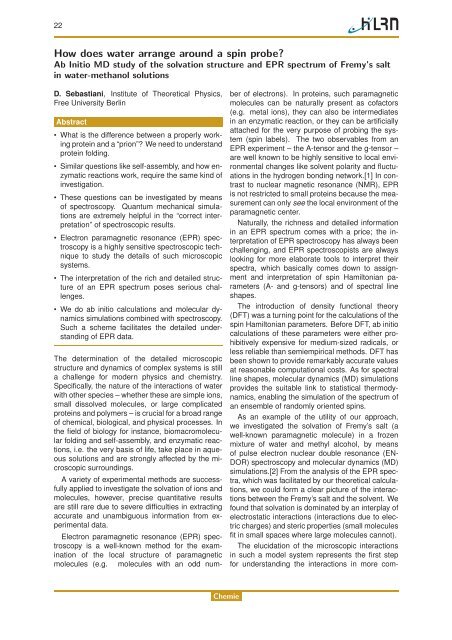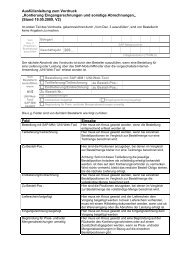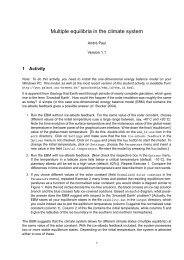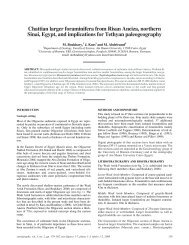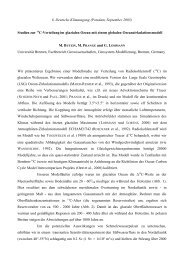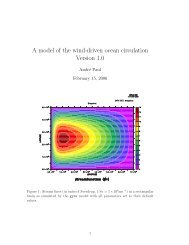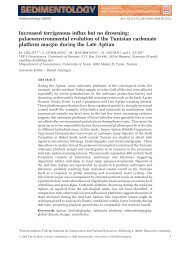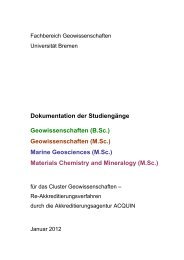Forschung im HLRN-Verbund 2011
Forschung im HLRN-Verbund 2011
Forschung im HLRN-Verbund 2011
- Keine Tags gefunden...
Erfolgreiche ePaper selbst erstellen
Machen Sie aus Ihren PDF Publikationen ein blätterbares Flipbook mit unserer einzigartigen Google optimierten e-Paper Software.
22How does water arrange around a spin probe?Ab Initio MD study of the solvation structure and EPR spectrum of Fremy’s saltin water-methanol solutionsD. Sebastiani, Institute of Theoretical Physics,Free University BerlinAbstract• What is the difference between a properly workingprotein and a “prion”? We need to understandprotein folding.• S<strong>im</strong>ilar questions like self-assembly, and how enzymaticreactions work, require the same kind ofinvestigation.• These questions can be investigated by meansof spectroscopy. Quantum mechanical s<strong>im</strong>ulationsare extremely helpful in the “correct interpretation”of spectroscopic results.• Electron paramagnetic resonance (EPR) spectroscopyis a highly sensitive spectroscopic techniqueto study the details of such microscopicsystems.• The interpretation of the rich and detailed structureof an EPR spectrum poses serious challenges.• We do ab initio calculations and molecular dynamicss<strong>im</strong>ulations combined with spectroscopy.Such a scheme facilitates the detailed understandingof EPR data.The determination of the detailed microscopicstructure and dynamics of complex systems is stilla challenge for modern physics and chemistry.Specifically, the nature of the interactions of waterwith other species – whether these are s<strong>im</strong>ple ions,small dissolved molecules, or large complicatedproteins and polymers – is crucial for a broad rangeof chemical, biological, and physical processes. Inthe field of biology for instance, biomacromolecularfolding and self-assembly, and enzymatic reactions,i.e. the very basis of life, take place in aqueoussolutions and are strongly affected by the microscopicsurroundings.A variety of exper<strong>im</strong>ental methods are successfullyapplied to investigate the solvation of ions andmolecules, however, precise quantitative resultsare still rare due to severe difficulties in extractingaccurate and unambiguous information from exper<strong>im</strong>entaldata.Electron paramagnetic resonance (EPR) spectroscopyis a well-known method for the examinationof the local structure of paramagneticmolecules (e.g. molecules with an odd numberof electrons). In proteins, such paramagneticmolecules can be naturally present as cofactors(e.g. metal ions), they can also be intermediatesin an enzymatic reaction, or they can be artificiallyattached for the very purpose of probing the system(spin labels). The two observables from anEPR exper<strong>im</strong>ent – the A-tensor and the g-tensor –are well known to be highly sensitive to local environmentalchanges like solvent polarity and fluctuationsin the hydrogen bonding network.[1] In contrastto nuclear magnetic resonance (NMR), EPRis not restricted to small proteins because the measurementcan only see the local environment of theparamagnetic center.Naturally, the richness and detailed informationin an EPR spectrum comes with a price; the interpretationof EPR spectroscopy has always beenchallenging, and EPR spectroscopists are alwayslooking for more elaborate tools to interpret theirspectra, which basically comes down to assignmentand interpretation of spin Hamiltonian parameters(A- and g-tensors) and of spectral lineshapes.The introduction of density functional theory(DFT) was a turning point for the calculations of thespin Hamiltonian parameters. Before DFT, ab initiocalculations of these parameters were either prohibitivelyexpensive for medium-sized radicals, orless reliable than semiempirical methods. DFT hasbeen shown to provide remarkably accurate valuesat reasonable computational costs. As for spectralline shapes, molecular dynamics (MD) s<strong>im</strong>ulationsprovides the suitable link to statistical thermodynamics,enabling the s<strong>im</strong>ulation of the spectrum ofan ensemble of randomly oriented spins.As an example of the utility of our approach,we investigated the solvation of Fremy’s salt (awell-known paramagnetic molecule) in a frozenmixture of water and methyl alcohol, by meansof pulse electron nuclear double resonance (EN-DOR) spectroscopy and molecular dynamics (MD)s<strong>im</strong>ulations.[2] From the analysis of the EPR spectra,which was facilitated by our theoretical calculations,we could form a clear picture of the interactionsbetween the Fremy’s salt and the solvent. Wefound that solvation is dominated by an interplay ofelectrostatic interactions (interactions due to electriccharges) and steric properties (small moleculesfit in small spaces where large molecules cannot).The elucidation of the microscopic interactionsin such a model system represents the first stepfor understanding the interactions in more com-Chemie


